Virtual research presentations are becoming increasingly common as more and more conferences are held partially or fully online. You might assume that you should prepare a virtual presentation the same way you would for an in-person event. But virtual presentations pose different challenges to presenters and audiences. Just flipping the same presentation from in-person to virtual mode will result in an unsatisfactory talk—as is seen all too often at research conferences. Here, we present 8 tips that will help you create a better virtual research presentation.
Virtual conferences offer a lot of flexibility to attendants, the presenters and their audiences. You don’t have to travel, you save time and money, and you can attend meetings that you would not otherwise be able to join in person. This gives off a relaxed atmosphere, and therefore virtual conferences can be very enjoyable and productive. But this relaxed atmosphere doesn’t justify a lack of proper preparation by presenters in virtual environments. If a talk has been prepared for in-person delivery, then it is not directly transferable to a virtual format. Different rules apply and different challenges come up that need to be addressed by any good presenter.
Here are 8 tips and suggestions that will help you improve your next presentation at a virtual conference:
1. Define your presentation aim
For any presentation, its aim needs to be clear. In virtual presentations, this is even more important. You do not see the audience and they do not see you the same way they would were you standing in front of them. Some of your audience will listen to your talk from their office where a lot of other small tasks are waiting for them. Others will join from the home office where potential disruptions and temptations surround them. Your task is to keep them interested in your talk from the beginning; a clearly defined presentation aim is essential for this. Make sure that the audience understands the purpose of your talk from the get-go because if your audience cannot follow you from the start, the temptation to do something else during a virtual talk is very high.
2. Use, learn and test technology
In the virtual environment, you’re faced with more technology than in an in-person presentation. Your audience and you are using technology to join the meeting. You cannot control what technology your audience is using, but you have control over the technology on your end.
Don’t assume that a presentation with low-technology input is necessarily a better one. There’s a certain technology standard that you should apply and be familiar with. You will use either in-built or external audio and video devices to capture your delivery from your computer, and the quality of these devices will impact what your audience will see and hear.
Use the best computer equipment and the fastest and most reliable Internet connection available to you, and make sure you have tested and are familiar with your set-up well before your presentation.
3. Use external microphones and cameras
The image and the sound that your audience receives impact the way they perceive, understand and judge your talk. If you’ve got the possibility, use external devices for audio and video streaming. Hearing a clear voice captured from an external microphone instead of using your built-in one is better for your audience. The same applies to your video. If you have access to a good external camera, place it on eye-level so that your face appears natural on screen and you’re not captured from an angle which makes you look funny. If you must use your in-built camera, use an additional stand to lift up your laptop to better frame your face.
4. Take care of lights and background
You don’t need professional level lighting, but your audience needs to be able to see you clearly during your virtual presentation, even when presenting your work desk or your kitchen table. If possible, use multiple light sources or face the window with daylight to lighten up your face. It helps your audience to see and read your expressions and gestures.
The background is not supposed to play a big role in a virtual research presentation but a background that is messy or noisy can be very distracting. You don’t need to blur your background (although many video conferencing tools include this tool) but have a careful look at the canvas that is displayed behind you. This is what the audience will see while you present. It is more natural to look at a presenter in front of a tidy and clean background than to guess what kind of mess the presenter is hiding with the blurred background.
5. Embrace rehearsal
Like with any presentation, rehearsal is the key to success. Even if you don’t see the audience and you are presenting from your cosy and familiar home environment, the presentation itself should be professional. In an in-person conference, there might be other people who can assist you during your talk (e.g. the chairperson or a tech person), but when you present virtually, you have to rely on your own skills.
All technical hiccups on your side need to be solved by you. And because you’re not only playing the role of the presenter but are also your own tech support, you need to check the time and your equipment yourself. You need to know your presentation well because during a virtual presentation, you will have to focus on many aspects simultaneously.
One typical obstacle to presentation success is unfamiliarity with the video conferencing tool chosen by the conference host. Familiarize yourself with the presentation platform ahead of time to ensure a good delivery.
6. Consider end-users’ devices
One aspect that you cannot control is the device that each member of your audience is using to follow the virtual conference. At an in-person conference, everyone faces the same stage and can see your slides on the same screen.In a virtual environment, audience members can use all sorts of devices.
You cannot assume that everyone is watching your presentation from a well-running laptop with a high-speed connection. Some people may watch on a large monitor, others will use a tablet, and some people join meetings from their phones. Your presentation should work on all of these devices!
Keep the layout of your presentation simple and display all text and graphs in a size that is readable even on mobile devices. Reduce the amount of text that you place on your slides.
7. Don’t hide behind slides
A research presentation is not just about your results and your graphics–it’s also about you! That applies to in-person presentations and even more to virtual ones. At an in-person conference, the audience can see you moving around and get an impression of your personality. It can be harder to convey who you are in a virtual setting. Therefore, make sure that your personality comes across to your virtual audience.
Don’t hide behind your slides and talk without giving your audience the chance to see you. Seeing you means establishing a connection with you and that’s what your audience wants. Make sure that the screen is not exclusively covered by your slides and that your face appears on the audience’s screens, be they big or small.
8. Connect with your audience and interact
Finally (and this is probably the most important tip for a great virtual presentation), give your audience a chance to interact with you. People at conferences get bored by passively being fed information with no chance for interaction. Sometimes, a whole conference can be like this, where the presenters are talking to their audience and they can only listen.
An audience is far more attentive and willing to engage with your content if you give them opportunities to connect with you. Ask them questions, relate to situations they are familiar with, let them rate a visual, vote on a statement, or offer short possibilities to ask questions in-between. These activities will make your presentation lively and foster a dialogue between your audience and you. Your audience will be grateful for any attempt you make to interact with them!

Conclusion
Successfully presenting at a virtual conference requires you to put yourself in the position of the audience. You must consider how to accommodate your virtual audience in a variety of situations to provide the best presentation experience for everyone tuning in. A presentation that you’ve prepared for an in-person conference doesn’t work very well in a virtual setting, but you can build on it and modify it to make it fit for an online conference. The eight suggestions above will help you to master the challenge of virtual presentations.
Related resources:
- Smart Academics Blog post #95: Apply these 5 tips to improve any presentation.
- Smart Academics Blog #70: Attending live Zoom courses successfully: The dos and don’ts!
- Smart Academics Blog #11: How much time is needed to prepare a good scientific presentation?
Related courses and services:
- 1-day course: Presenting successfully at virtual conferences
- 3-day course: How to present at international conferences
- 1-to-1 advice: Presentation Check
More information:
Do you want to present successfully at conferences?
If so, please sign up to receive our free guides.
Photo by Sebastian Pandelache at Unsplash
© 2023 Tress Academic
